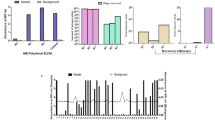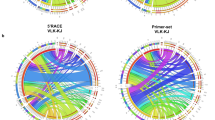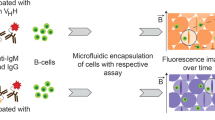Abstract
To make further investigation of the IgE antibody repertoire in Trichosanthin (TCS) allergic responses, a murine IgE phage surface display library was constructed(3.0 × 105 independent clones). We first constructed the Vɛ cDNA library (4.6 × 105 independent clones) and Vκ cDNA library (3.0 × 105 independent clones). Then, the Vɛ and Vκ gene segments were amplified from both libraries by PCR respectively, and assembled into Fab fragment by SOE PCR. The phage library containing Fabs was thus constructed. The diversity of Vɛ from this library was analyzed and proved. Fab clones with high specificity to TCS have been screened out.
Similar content being viewed by others
Introduction
In our previous study of Vɛ and Vκ from four anti-TCS IgE hybridomas established in our laboratory, we found Vκ from all four clones used fragments from the same germline gene family Vκ 21, and a bias in the use of Jk1 gene fragment was also observed. On the other hand, the gene usage of VH was quite diverse. We speculated that in IgE responses to TCS, the light chain may play a more important role in specific binding to allergenic determinant on TCS1. However, due to the limitation of hybridoma technology, it is difficult to achieve a large number of anti-TCS IgE clones. The recent advent of phage surface display antibody library technology provides us the opportunity to study anti-TCS IgEs on a bigger capacity. We constructed a human IgE phage antibody library from normal human peripheral blood lymphocytes and screened out two clones2. However their affinity to TCS was low, and the diversity of the library was not satisfactory, thus it could hardly provide us more useful informations about the IgE recognition of TCS.
In this study, we used TCS-immunized mice. Vɛ segments and Vκ segments were obtained through RT-PCR. First a Vɛ cDNA library and a Vκ cDNA library were constructed separately. Vɛ and Vκ fragments amplified from the two libraries were assembled into a large fragment by SOE PCR. The expression vector was reconstructed for the expression of Fab fragments. And factors which potentially influence the results of SOE PCR and the diversity of the library were analyzed at the same time. Based on these work, we constructed a phage surface display murine Fab library, and its diversity and the antigen specificity of the expressed clones were analyzed.
Materials and Methods
Plasmids and bacterial strains
Vector pHEN1, plasmid pSW1 Fab (D1. 3) and the E. coli strain TG1 were all kindly provided by Dr G. Winter, MRC, Cambridge. Plasmid pBluescript and bacterial strain XL1-Blue were from our laboratory.
Primers
Primers were designed according to Orlandi3

To ensure the specific amplification of Vɛ segments, a Cɛ primer was designed according to the constant region of IgE antibody for reverse transcription and PCR amplification.
Cɛ For primer:
5′-GAAGCAGTGCCTTTACAGGGCT-3′
RT-PCR amplification of Vɛ and Vκ segments
RNA was extracted from the mesenteric lymph node of C57BL/6J mice4, which had been immunized intraperitoneally at a dose of 5 μg of TCS (Jin San Pharmaceutical Factory) for 3 times. Appropriate primers were used for different amplification. Cɛ primer and Jk primer were used for first strand cDNA synthesis separately. For Vɛ segments, the cDNA sample was first amplified with Cɛ primer and VH primer and the resulting PCR products were used as template in the second round PCR amplification with primer VH and JH.
PCR was performed in a total volume of 50 μl, containing 5 μl of 10 × reaction buffer, 2 μl of 5 mM dNTPs, 1 μ1 of each appropriate back and forward Primer (25 pmol/ μl), 1 μl Taq DNA polymerase (2 μg/ μ1, Promega), 3μl cDNA sample and 37 μ1 ddH2O. The PCR was run for 35 cycles (94 °C 1 min, 50 °C 1 min, 72 °C 1 min).
Construction of Vɛ and Vκ cDNA library5
Vɛ and Vκ segments were ligated into pBluescript (SmaI) by blunt end ligation, which could decrease the possible loss of fragments in comparison with the method of restriction enzyme digestion. The subsequent cloning was carried out as routine. The ligation products were used to transform E. coli XL1-Blue through electroporation. The transformants were plated and counted to determine the capacity of the library. Three clones were randomly chosen from the libraries, two from Vɛ cDNA library and one from Vκ eDNA library. They were sequenced to check whether they belonged to immunoglobulin genes.
Reconstruction of the expression vector
For convenient expression of Fab fragment of mouse, we introduced Cκ segment into pHEN1. CH1 Fablinker fragment was amplified from pSW1D1.3 plasmid with primer rJH and rVk and digested by XhoI and NotI. After recovered and purified by agarose gel electrophoresis, the Cκ fragment was ligated into pHEN1 (XhoI, NotI) to construct an expression vector pHEN1Cκ.
Assembly of Vɛ and Vκ segments by SOE PCR6
All fragments used for SOE PCR should be purified through low melting point agarose gel electrophoresis. The SOE PCR included two steps: First, a 40 μl reaction mixture was prepared, which contained 4 μl of 10 ×reaction buffer, 2 μl of 5 mM dNTPs, each sample 250 ng at least, and 2 μl Taq DNA polymerase (2 u/μ1, Promega). The reaction cycle was 94 °C 1min and 75 °C 3 min. After 7 cycles, the temperature was held at 72 °C and another mixture was added. This mixture was 10 μl in volume, including 50 pmol each appropriate primer and 1 μl of 10×reaction buffer. After thoroughly mixing the second cycling was started immediately. The cycle was 94 °C 1 min, 50 °C 1 min, 72 °C 2 min. After 20 cycles, the reaction mixture was held at 72°C for 5 min. (Fig 1)
Construction of phage surface display library and analysis of the diversity of Vɛ segments
The fragments assembled through SOE PCR were digested with SfiI and XhoI, and recovered through low melting point gel electrophoresis. Ligation products were used to transform XL1-Blue by electroporation. Ten clones were selected from two libraries (Vɛ cDNA library and phage library) at random. The Vɛ fragments were amplified from these clones and digested with HaeIII, RsaI and MspI (SABC). The products were loaded onto 8 % PAGE gel for electrophoresis. Band patterns from electrophoresis would indicate the differences among these Vɛ segments.
Screening of the anti-TCS Fab clones from the phage antibody library
1) Generation of phage antibody
The phage antibody library transformed bacteria were inoculated into 2× TY broth containing 100 μg/ml Amp and 1% Glu and grown at 37 °C with shaking. After centrifugation and resuspending, helper phage (M13-K07) were added and cultured again. The phage particles were repeatedly precipitated with PEG. After centrifugation the phage particles were resuspended in 3 ml PBS-1 % BSA. 1012 phage particles in suspension were added to TCS (20 μg/ml) coated and 1% gelatin blocked plate (Cel-cult, six wells). They were held in room temperature for 2 h. The plates were washed thoroughly first with PBS-0.1% Tween and then with PBS. The phage particles were eluted with 100 mM triethylamine. The eluates were neutralized with 1. 0 M Tris-HCl (Ph 7.4). They were used to transform XL1-Blue at standstill for 45 min and then plated on 2YT-Amp-Glu plates.
2) ELISA analysis of the phage antibody and the soluble Fab:
ELISA for phage antibody: Clones grown on the plates were picked up and cultured in 2YT-Amp-Glu overnight till the OD600 up to 0.5. Helper phages were added and cultured with shaking again. After centrifugation and resuspending, the phage suspension was subjected to ELISA. The ELISA plate was separately coated with TCS, OVA (Sigma), and BSA (Dong Fong Reagent Co). Phage suspension was added. After washing, anti-M13 antiserum (prepared in our lab) and peroxidase labeled goat anti-rabbit Ig antibodies (BioRad) were added in turn. The OD value was read with a ELISA Reader (Bio-Tek).
ELISA for soluble Fab: Phages were used to transfect E. coli HB2151, and cultured in 2YT-Amp till the OD600 up to 0.9. Then IPTG was added and they were cultured for another 18 h. After centrifugation the supernatant was used for routine ELISA. Test antigens were coated as above.
Results
1. RT-PCR amplification of Vɛ and Vκ segments
Results from electrophoresis showed that the Vɛ and Vκ bands were of expected size, with Vɛ about 350 bp and Vκ about 320 bp. (Fig 2)
The capacity of the two cDNA libraries were: 4.6 × 105 independent clones for Vɛ cDNA library and 3.0 × 105 clones for Vκ cDNA library. Results from sequencing of the three cDNA clones from the two libraries showed that all of them belonged to immunoglobin genes. The putative germ-line genes used by V, D, J gene segments of Clone VH2, VH6 and Vκ3 were shown in Tab Tab 1.
2. The identification of vector pHEN1Cκ
To determine whether the Cκ insertion in the vector pHEN1 was correct, XhoI and NotI were used to digest the constructed vector pHEN1Cκ. The electrophoresis results showed there was a band about 300bp which was of the expected size of Cκ fragment (Fig 3).
3. Vɛ and Vκ fragments assembled by SOE PCR
First, Vκ was assembled with CH1Fablinker. The products were about 800 bp as expected. The resulting products, CH1 Fab linker Vκ fragments, were then assembled with Vɛ fragments. The products were about 1.1 kb (Fig 4).
4. Diversity analysis of the Vɛ fragments from cDNA library and phage library
VH Back and JK For primer were used to amplify Vɛ fragments of the clones randomly chosen from both libraries. The Vɛ fragments were digested with restriction enzyme HaeIII, MspI and RsaI separately. The digested products were loaded onto 8 % PAGE gel. Electrophoresis results showed the differences among the Vɛ segements, which suggested that the Vɛ in phage library still kept the diversity as it was in vivo. (Fig 5, Fig 6).
5. ELISA results:
Two phage antibody clones, Fab2 and Fab7, were chosen from library screening. Both phage-ELISA and soluble Fab-ELISA all showed the TCS-specific binding of the two Fab clones, with Fab 7 with higher binding specificity. (Tab 2, Tab 3)
Discussion
cDNA library construction
That TCS alone (without using adjuvant) can induce specific IgE responses has been proved in our laboratory7. In the lymphocyte repertoire, B cell clones producing TCS-specific antobodies including specific IgE were surely enriched. The Vɛ and Vκ cDNA library derived from the repertoire would accordingly reflect the distribution of the different B cell clones. After antigen selection (library screening) it is possible to probe the in vivo IgE responses from the in vitro constructed repertoire (phage antibody library). The reason that we first constructed the two cDNA libraries instead of assembling Vɛ and Vκ directly from cDNA PCR products is due to our previous experiences that the specific amplification bands were seldom acquired and non-specific amplification was very strong. In order to keep the diversity more close to the status in vivo, the fragments were ligated into pBluescript through blunt end ligation. Otherwise some segments would most probably be lost during restriction enzyme digestion for cloning. Two clones and one clone have been randomly selected from Vɛ and Vκ library respectively. Their sequences showed that all of them were from immunoglobulin V region genes (data not shown). Thus, the RT-PCR amplification products were specific for Ig V region genes. To ensure specific amplification of Vɛ fragments nested PCR were used to guarantee that the amplified fragments were Vɛ.
Assembly of antibody fragment by SOE PCR
So far as the method of assembly of VH and VL into Fab fragment, specific enzyme digestion and then cloning into vectors are frequently used in the papers. The method is relatively simple and direct. However, it is not uncommonly to find that limited clones are obtained. In condideration of preserving the diversity as much as possible, SOE PCR seems to be a method of choice, because it reduces the loss during enzyme digestion. To preserve the diversity of Vɛ fragment, a degenerate primer (Vɛ Back) was used in Vɛ amplification. However, it caused a number of nonspecific amplification during SOE PCR. Therefore, we had to construct the cDNA library of Vɛ and Vκ respectively. Since more plasmids could be obtained from cDNA library of Vκ and Vɛ and more Vκ and Vɛ fragments could be got to be used as PCR templates, thus the PCR amplification rounds could be reduced. Furthermore it is easy to get more Vɛ and Vκ fragments as templates of SOE PCR, which in turn provides sufficient amount of SOE PCR products for library construction and need not to do another round of amplification of SOE PCR products, thus reducing error synthesis8.
In this study we found that the overlap length of the primer (Forward and Reverse primer) should be over 30 base pairs. If the overlap is more than 30 base pairs, the annealing and extension temperature in the first step of assembly could be set at 75 °C. It is higher than usual, thus also reducing nonspecific amplification.
The diversity of the library
The diversity of the library is of prior importance for further study of the TCS-specific IgE responses. From Fig 5 and 6, it indicated that 6 clones randomly picked up from Vɛ cDNA library and 8 clones randomly picked up from phage Fab library were all different clones. Hence it proved there was no obvious loss of diversity in the two libraries and highly specific antibody clones could be screened out. Although the capacity of the library seems not big enough, 3 × 105 clones, however the frequency of IgE-producing B cells is very small. It was reported, in human PBL IgE-producing B cells frequently only account for 0.001% −0.01%9. In this sense the library constructed may probably provide sufficient information to analyse TCS-specific IgE responses. However, it should point out that during the construction of library, some technical factors may influence the diversity, such as errors from PCR amplification, enzyme digestion, and transformation efficiency. We should be aware of them during library construction.
The most straight forward method to study diversity is sequencing, however, it is labor intensive. The present enzyme digestion method using 3 restriction enzymes with 4 bp recognition site provides an alternative. The fine digestion patterns shown in electrophoresis indicate it could be used instead.
Phage Fab and soluble Fab
In Tab 3 the ELISA values of soluble Fabs are not as specific and higher as that of the phage Fabs. Since our vector is not high expression vector, the expression products in the culture supernatant are not in high concentration. This may be one of the reasons. Futhermore, in ELISA used for determination of soluble Fabs, after adding soluble Fab only one second layer antibody (Fab-specific) is added. While in phage ELISA, the Fabs are expressed on the phage particles and both second layer antibody, rabbit anti-M13 antiserum and, third layer antibody, goat anti-rabbit Ig antibodies, are used, so the amplification is bigger. This may also explain the differences.
References
Wang Y, Yeh M . Molecular Characteriation of the V regions of four IgE antibodies specific for Trichosanthin. Immunology 1996; 89(3):316–23.
Zan Hong, Ming Yeh . Construction of normal human IgE phage antibody library and the screening of the anti-trichosanthin IgE. Cell Research 1996; 6:1–9.
Orlandi R, Gussow DH, Jones PT, Winter G . Cloning immunoglobulin variable domain for expression by the Polymerase Chain Reaction. PNAS 1989; 86:3833–7.
Chomczynski P, Sacchi N . Single-Step method of RNA isolation by acid gunanidinium thiocyanatephenol-chloroform extraction. Anal Biochem 162(1):156–9.
Sambrook J, Fritsch EF, Maniatis T . Molecular Cloning. Cold Spring Harbor Laboratory Press 1989.
Horton RM, Hunt HD, Ho SN, Pullen Jk, et al. Engineering hybrid genes without the use of restriction enzymes: gene splicing by overlap extension. Gene 1989; 77:61–8.
Ji YY, Yang CH, Yeh M . The influence of Trichosanthin on the induction of IgE responses to ovalbumin under adjuvant-free condition. Cell Research 1995; 5:67–74.
Ho SN, Hunt HD, Horton RM, Pullen JK, et al. Site-directed mutagenesis by overlap extension using the polymerase chain reaction. Gene 1989; 77:51–9.
Sparholt SH, Barington T, Schon C . Detection of B-lymphocytes secreting antibodies to Dematophaoides antigens. Clin Exp Allergy 1991; 21:85–9.
Acknowledgements
The work was supported by the Director Grant of Shanghai Institute of Cell Biology, Chinese of Academy of Sciences, and also supported by the World Laboratory. We are most grateful to the generous and great help of Dr. Greg Winter in Cambridge, England.
Author information
Authors and Affiliations
Corresponding author
Rights and permissions
About this article
Cite this article
Li, Z., Yeh, M. Construction and diversity analysis of a murine IgE phage surface display library. Cell Res 7, 161–170 (1997). https://doi.org/10.1038/cr.1997.17
Received:
Revised:
Accepted:
Issue Date:
DOI: https://doi.org/10.1038/cr.1997.17









